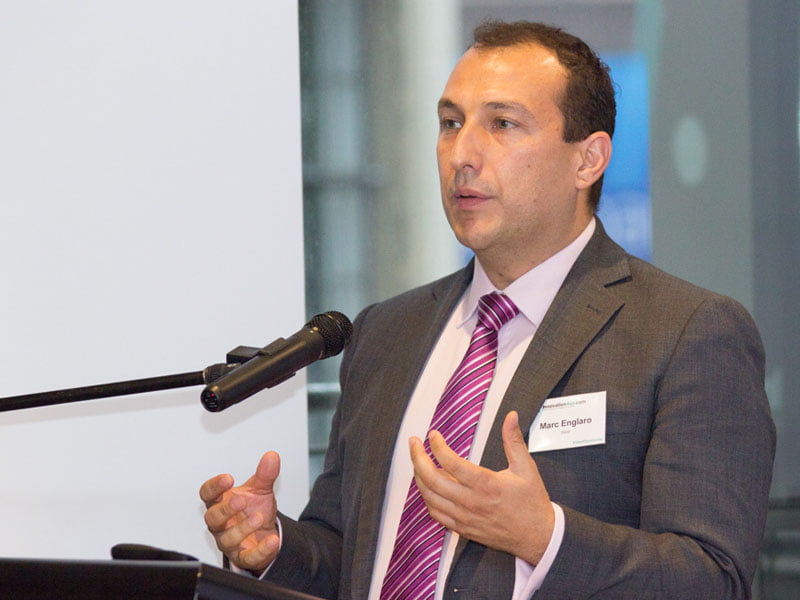Marc Englaro is Director of Customer Insights at Australian customer experience and digital services company Squiz. While the focus of the digital transformation narrative is on the technology, Mr Englaro says the high-value parts of these transactions remains human-scale.
Ultimately, he says, digital transformation and digital disruption is about delivery value to people – or connecting people to services or connecting people to people.
“Customer experience is a fancy way of saying we put together lots of different bits of technology, process and expertise to help our customers interact with their customers,” he says. “We are in an era of unprecedented change – the buzzword is ‘digital transformation’ – where digital technology is transforming the way we interact with people.

“The sorts of technology we use to build CX platforms includes Sugar CRM, which is a tool for merging human interactions, and e-commerce tools, web tools, mobile tools, data analytics, marketing automation – we use them all to build unified experiences where our conversations provide value through to their stakeholders.”
Mr Englaro spoke at the InnovationAus.com Open Opportunity Forum on ‘Humanising Transformation’ – on the importance of human interaction in digital transformation.
Mr Englaro joined Squiz 18 months ago when it acquired his company InsightfulCRM. He specialises in the customer experience (CX). He spoke on behalf of Squiz business partner Sugar CRM, a sponsor of the Open Opportunity Forum.
He gave Uber and Airbnb as examples of digital transformation – but also about the essential human element in the success of both companies.
“Uber is about connecting people who have transport with people who need transport, and Airbnb is about connecting people who have accommodation with people who need accommodation.
“There is no doubt that those companies are driven very heavily by the digital technology that underpins them, but ultimately what they are doing is connecting people with people and delivering value. They are disintermediating markets, but it is the people that are the important element.
“Digital is not an outcome, it is an enabler for delivering value to people.”
It is the people element that fascinates Mr Englaro. He gives the example of professional sales. “That sector has been rapidly changed by access to information. It wasn’t that long ago that if you wanted information about a product or a service you would call a sales person and they would give you a presentation or a demo. You asked them lots of questions, and who their competitors were – you would use the sales person as a travelling source of information.
“But today all of that information is online. Some reports suggest that 80 percent of the sales exercise is now done online, before someone contacts the company in the real world.
“The interesting thing about that is that the remaining 20 percent is still about a person talking to a person.
“The people are reserved for the most valuable part of the transaction. Technology can automate all the easy stuff, but the really high value components are when a person interacts with a person.”
Mr Englaro said there is something about a person interacting with a person that is different than interacting with a purely digital experience. “It is probably something emotional, probably something to do with trust.”
He gave the example of department store chain David Jones “Only just last week David Jones announced that they were hiring 1500 new people to put in their retail stores to provide a better customer experience. There is something about interacting with a human that is still important.
“So for those humans amongst us, the news is not all bad. Technology can help us be better at our jobs, it doesn’t only take things away from us.”
Another example he gave was of the Queensland University of Technology. “They have a program associated with the retention and experience of students. The program identifies those students at risk of dropping out. If a student drops out, it is a bad thing for two reasons: the university no longer collects student fees, and a student that drops out has a bad life experience.
“Not only did they have a poor experience with the concept of continuing their education, they possibly left with a student debt and are worse off than if they had not enrolled in the first place. It’s important to QUT that all students who enrol are successful.”
Squiz showed them how to use the Sugar CRM interface between the university and the student to identify those students who were at risk, using data analytics to evaluate a number of risk factors, to find those students before it was too late to prevent them dropping out.
“The university’s research showed that if they could get a student to talk to a human and connect them to the support services that already exist at the university, that they would get a 50 percent better retention rate than if they weren’t able to have a human-to-human connection.
“A lot of technology was used in the analytics to identify the students at risk, and about recommending which services were appropriate to each student, to connect advisors with all the available resources but still deliver them as a human interaction.”
Mr Engaro pointed to analysis from research firm Forrester, which each year benchmarks CX scores in major companies all around the world.
“They rank them based on how customers feel about their experiences with those companies. Those companies that are digital only score worse in CX than those that have a blended digital and human experience. All the top ranking companies have both a digital and a human component.
“While digital is a driving factor and a source of disruption, it is not an outcome in its own right. We must never forget that there are humans involved.
Do you know more? Contact James Riley via Email.

